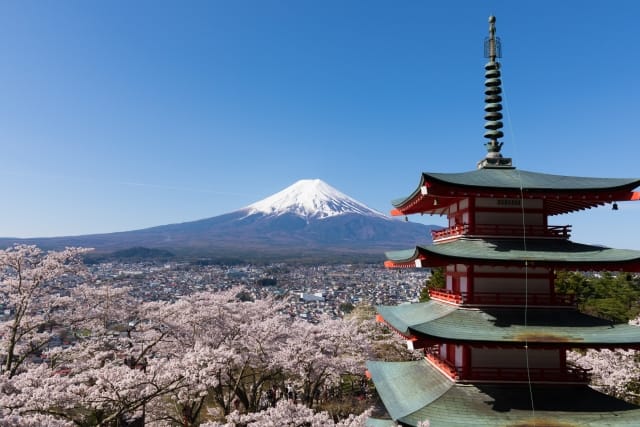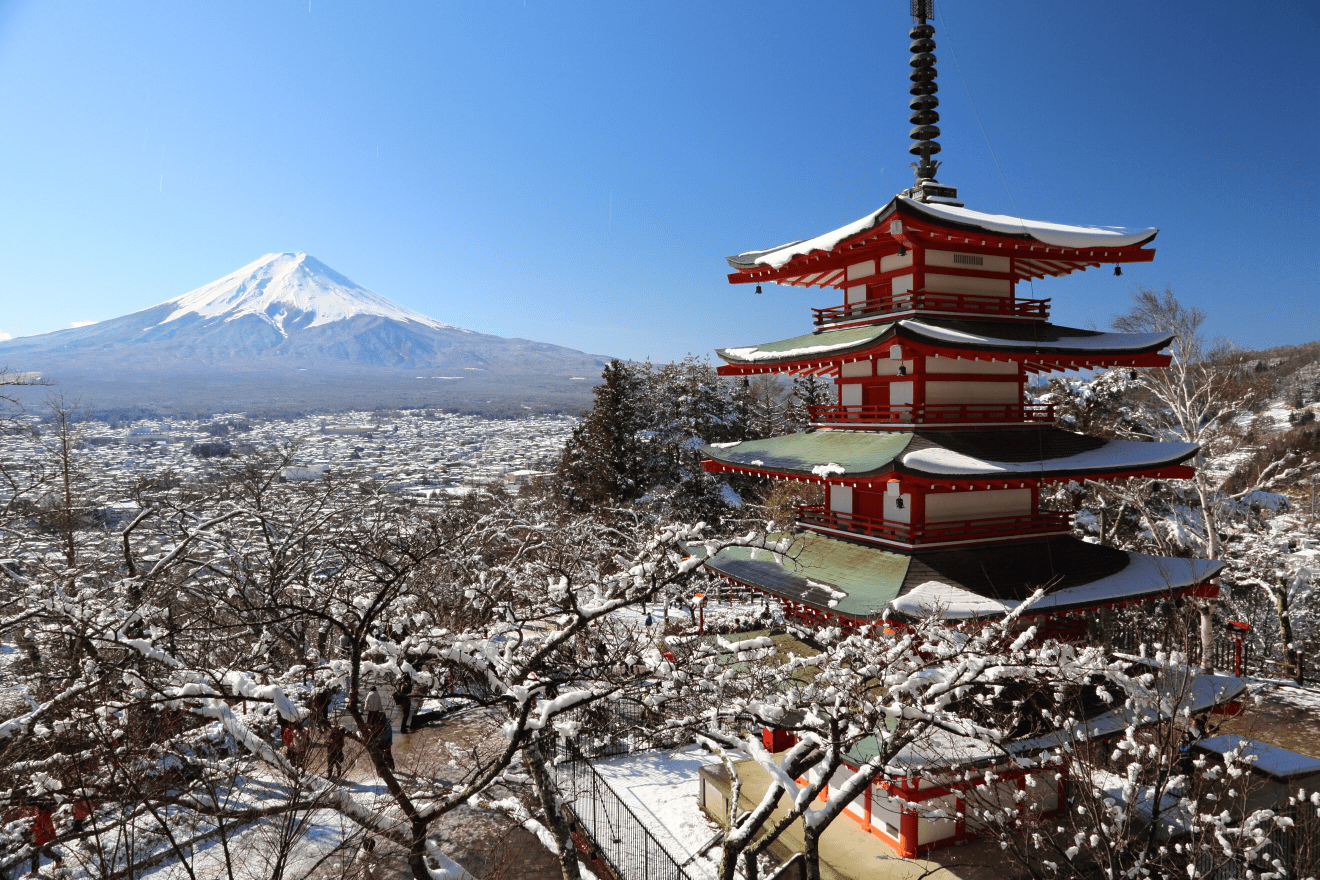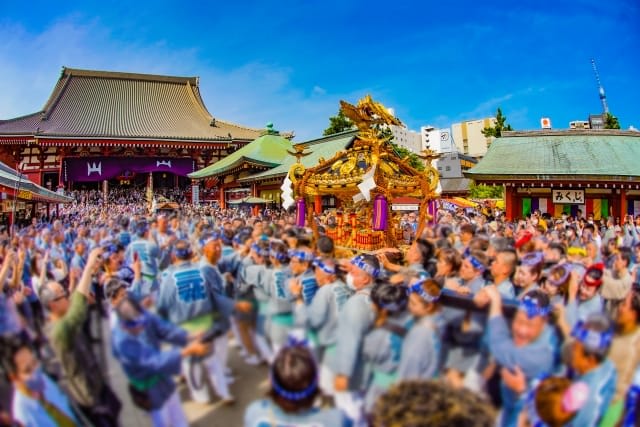Arakura Fuji Sengen Shrine 2026: Iconic Views of Mount Fuji with Chureito Pagoda and Cherry Blossoms
Due to Mount Fuji's massive size and the scattered tourist spots around its base, planning an efficient itinerary can be quite challenging for visitors. I remember when I first visited the Mount Fuji area, I wasn't able to efficiently visit the surrounding attractions, which left me feeling like I hadn't fully experienced what the region had to offer.
As a result, tours that offer an efficient and immersive way to experience the Mount Fuji area are gaining popularity. Private tours led by guides who know the Mount Fuji region inside and out are especially in demand, as they're known for allowing small groups to fully enjoy both the cultural and natural attractions around the mountain.
Magical Trip, which boasts having the #1 rated tour of 2024, launched a new tour in November 2024 called "Mt. Fuji Full-day Nature Guided Tour with a Private Chartered Car." On this tour, a driver and an expert local guide take you to carefully selected must-see spots around Mt. Fuji while explaining the local culture and traditions.

Since the tour starts and ends at your Tokyo hotel, you can explore the Mt. Fuji area hassle-free. If you're interested in Mt. Fuji but don't have time for an extended stay in the area, consider this efficient sightseeing tour.
Introduction
Mount Fuji is Japan's symbolic mountain located in Yamanashi Prefecture. Standing at 3,776 meters, it is Japan's highest peak, and both the mountain and its surrounding areas have been considered sacred since ancient times.
The surrounding area features beautiful lakes known as the Fuji Five Lakes, including Lake Kawaguchiko. Many people visit Yamanashi Prefecture to enjoy climbing Mount Fuji, experience the surrounding nature, and witness the spectacular views of Mount Fuji from nearby locations.
Today, we'll introduce one of the representative shrines around Mount Fuji, the Arakura Fuji Sengen Shrine. For those looking to experience multiple Mt. Fuji locations efficiently, consider a comprehensive guided tour of the Mt. Fuji area. It's a highly popular spot in Yamanashi Prefecture that offers views symbolic of Japan.
What is Arakura Fuji Sengen Shrine?
Arakura Fuji Sengen Shrine is located on Mt. Arakura (arakura-yama) near Mount Fuji in Yamanashi Prefecture. Founded in the 8th century, it has nearly 1,300 years of history.
The shrine's most distinctive feature is the spectacular view from its grounds. Known as one of the best spots to view Mount Fuji, it attracts many domestic and international tourists.
The sight of the beautiful traditional five-story pagoda, the symbol of Mt. Arakura, standing alongside Mount Fuji, creates a scene that epitomizes Japan. It's also famous for the view of Mount Fuji framed by the large red torii gate along the approach path.
Additionally, the shrine is popular as a scenic spot for cherry blossoms in spring and autumn foliage, thanks to its numerous cherry trees.
Why are Shrines Special to Japanese People?
Shrines are places of worship in Shinto, Japan's indigenous religion. Shinto has a history spanning thousands of years and has been practiced in Japan since ancient times. It's characterized by the belief that divine spirits dwell in all aspects of nature. Shinto forms a major foundation of current Japanese culture and history.
Shrines are considered sacred domains distinct from the secular world, believed to be dwelling places of the gods. The torii gates commonly seen at Japanese shrines mark the boundary between the human world and the divine realm.
A notable characteristic of Shinto is its numerous deities, with different shrines enshrining different gods. In most cases, the enshrined deities are believed to dwell in local natural features and protect the area's peace.
Japanese people visit shrines on various occasions to offer gratitude and prayers to the gods who protect the land and its people.
5 Attractions of Arakura Fuji Sengen Shrine
The Spectacular Collaboration of the Five-Story Pagoda and Mount Fuji
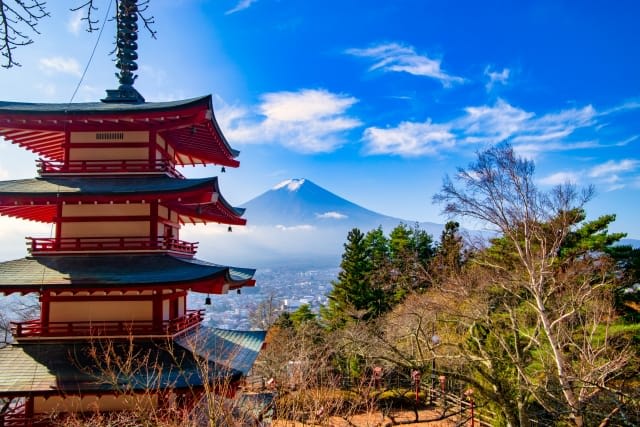
The shrine's main attraction is the spectacular view created by the collaboration between the beautifully architected pagoda and the majestic Mount Fuji visible from Mt. Arakura.
Mt. Arakura has long been famous as a spot offering beautiful views of Mount Fuji. From here, there are no obstructions to the view of Mount Fuji standing firmly in Fujiyoshida.
Furthermore, the five-story pagoda was completed on the mountainside of Mt. Arakura in the 1960s. Modeled after the famous Shitennoji Temple in Osaka, it features traditional architectural style and beauty.
From the mountainside, visitors can see a picture-perfect scene combining Mount Fuji, the pagoda, and the shrine's cherry blossoms and autumn foliage. This spectacular view has become renowned as a quintessentially Japanese scene, making it an extremely popular destination today.
The Secret Behind the Popularity of the Five-Story Pagoda "Chureito"
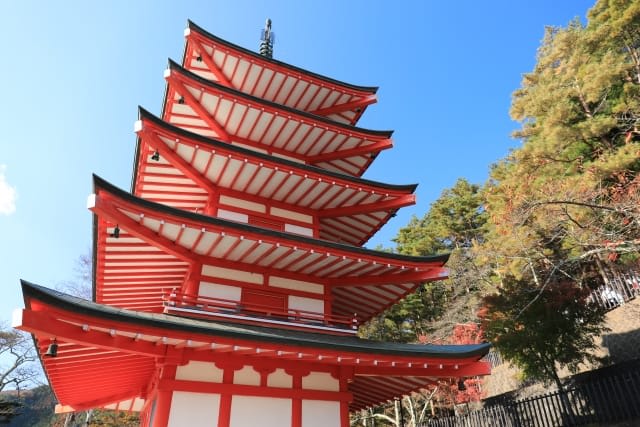
The iconic five-story pagoda at Arakura Sengen Shrine, officially named "Chureito," is located within Arakura Sengen Park on the slopes of Mount Arakura.
The Chureito Pagoda was built to commemorate those who lost their lives in wars Japan participated in since the late 19th century. Modeled after the famous Shitennoji Temple in Osaka, it was completed in 1962.
The pagoda's current popularity surge began with Mount Fuji's UNESCO World Heritage registration in 2013. Around this time, a 398-step staircase was constructed for safe access, along with an observation deck perfectly positioned for viewing both the pagoda and Mount Fuji.
From the observation deck, visitors can capture stunning photographs that frame the pagoda, Mount Fuji, and seasonal cherry blossoms or autumn leaves in a single shot. As a result, the Chureito Pagoda and observation deck are now consistently bustling with tourists.
Dramatic Seasonal Natural Landscapes
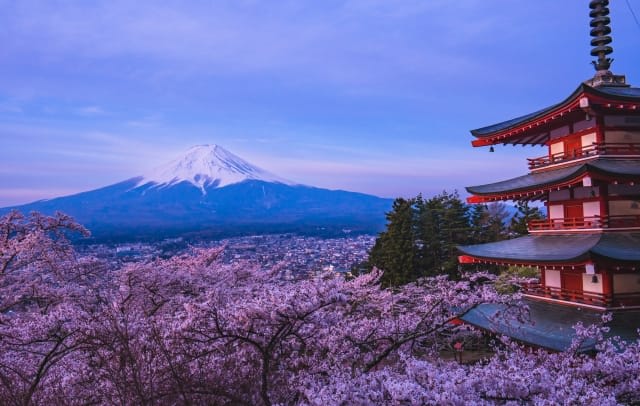
One of Arakura Sengen Shrine's main attractions is its ability to showcase Mount Fuji alongside the changing seasonal landscapes of Mount Arakura.
The shrine is nationally renowned as a cherry blossom viewing spot in spring, drawing visitors from far and wide. From May through summer, visitors can enjoy the brilliant fresh greenery against the backdrop of a pristine summer Mount Fuji.
The autumn foliage rivals the spring cherry blossoms in fame, with trees turning vibrant red and yellow, creating a spectacular scene with Mount Fuji. Winter brings a mystical charm with its snow-covered landscape.
These distinctly Japanese seasonal variations make this location popular with tourists year-round.
Sacred Atmosphere and Rich History: Home to Mount Fuji's Guardian Deity
Source:Fujiyoshida City Guide
Mount Fuji's guardian deity is the goddess Konohana-sakuya-hime, a prominent figure in Shinto religion enshrined across Japan.
At Arakura Sengen Shrine, Konohana-sakuya-hime is enshrined as Mount Fuji's protector. According to mythology, she gave birth in fire, making her also a fire deity. Given Mount Fuji's history of eruptions, she is enshrined here to pacify volcanic activity and natural disasters.
As cherry blossoms are Konohana-sakuya-hime's sacred trees, numerous cherry trees are planted throughout the shrine grounds. The shrine's elegant and sacred atmosphere stems from centuries of devoted worship to this beautiful goddess of Mount Fuji.
Popular Hiking Course on Mount Arakura
Source:Fujiyoshida City Guide
The hiking course that passes through the shrine to Mount Arakura's summit is another popular attraction.
Mount Arakura exemplifies Yamanashi Prefecture's rich natural environment. While the shrine and park at its base and middle slopes are famous for cherry blossoms and maple trees, continuing toward the summit reveals abundant alpine plants.
A notable highlight is the iris colony that blooms in June, about a 10-minute walk from the Chureito Pagoda. From personal experience visiting in June, the purple irises are stunning, and the mountain air is refreshingly crisp.
Beyond the iris colony, the trail becomes considerably steep. Proper hiking shoes and attire are recommended. The view of Mount Fuji from the summit, higher than the shrine and park, is even more magnificent and refreshing.
For those with sufficient time and energy, we recommend enjoying this nature-filled hiking experience to the summit.
Seasonal Highlights of Arakura Fuji Sengen Shrine: A Complete Guide
The main attraction of Arakura Fuji Sengen Shrine lies in its ever-changing scenic beauty throughout the seasons. The natural landscape of Mt. Arakurayama and Mt. Fuji transforms dramatically as the seasons change. Let's explore the highlights from spring cherry blossoms to winter scenery.
Cherry Blossom Season (Spring)
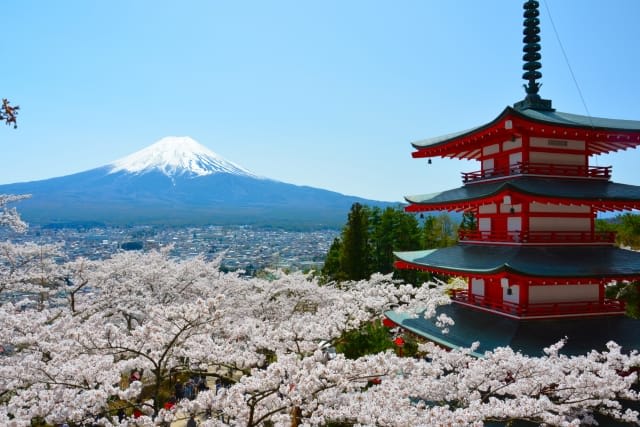
The shrine sees its peak visitor numbers during the spring cherry blossom season. Around 650 light pink Somei Yoshino cherry trees line the shrine approach and surround the five-story pagoda in Sengen Park. Plan your visit with our half-day Mt. Fuji itinerary.
The majestic Mt. Fuji and the pagoda create a picturesque scene amidst the sea of cherry blossoms, resembling a perfect painting. The best viewing time is from late March to early April, with the Cherry Blossom Festival held annually from late March to early April.
The highlight is the observation deck in Sengen Park, offering the most stunning views of the cherry blossoms, Mt. Fuji, and the five-story pagoda. After climbing 398 steps from the shrine, you'll reach the park with the pagoda. Further steps lead to the observation deck with breathtaking views.
Due to high visitor numbers during cherry blossom season, viewing time at the observation deck is limited to 5 minutes per group. Though brief, I was thoroughly satisfied with the beautiful photos I captured. As the most recommended photo spot, the observation deck is definitely worth the climb.
Spring Season Guide around Mt.Fuji:
Mount Fuji in Spring: Complete Guide to Cherry Blossoms, Events & Activities 2026
Autumn Foliage Season
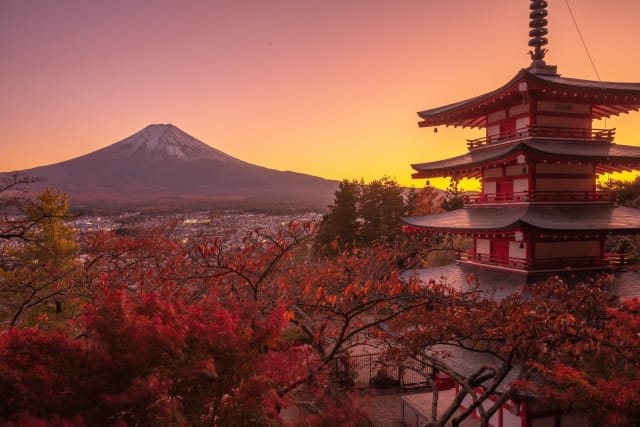
Equally famous is the autumn foliage season. While the cherry trees shed their leaves, the maple trees turn brilliant shades of red and yellow, beautifully adorning the red pagoda. Against the backdrop of the distant blue Mt. Fuji, it creates an elegant Japanese landscape.
By autumn, Mt. Fuji's peak is already dusted with snow, which is said to enhance its beauty. The view from the observation deck, combining the snow-capped Mt. Fuji, autumn foliage, and the pagoda, is unmissable.
The landing areas along the stairs to the observation deck also offer beautiful views of the autumn leaves and Mt. Fuji. The area around the grand torii gate along the approach path is another recommended spot for photographing the red maples, massive torii gate, and Mt. Fuji together.
Autumn Season Guide around Mt.Fuji:
Autumn at Mt. Fuji: A Complete Guide for Foreign Visitors
Fresh Greenery Season (Summer)
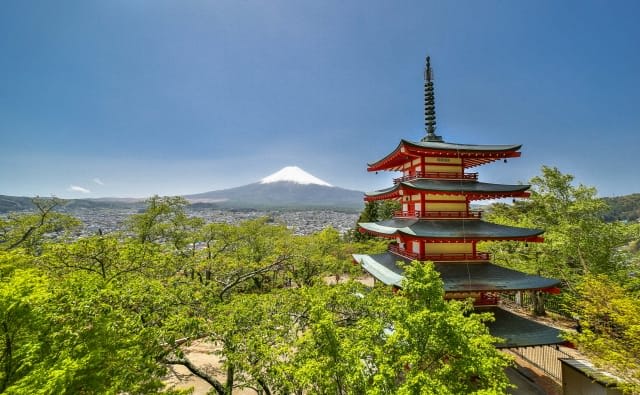
From late April, after the cherry blossom season ends completely, the pink petals fall and trees don their green leaves.
During this season through summer, the shrine and park are bathed in brilliant green. Some maple trees along the approach path turn red in early summer, creating beautiful gradients with the surrounding greenery. The park also features lovely summer flowers.
During my early summer visit, looking through the famous red torii gate along the approach path revealed a refreshing view of Mt. Fuji adorned with green foliage. The sunlight dancing on the fresh greenery throughout the shrine and park grounds left a lasting impression.
A pleasant bonus during this season is the reduced number of visitors compared to cherry blossom and autumn foliage seasons, allowing for peaceful shrine visits. Popular spots like the grand torii gate and observation deck can be enjoyed at a leisurely pace.
Summer Season Guide around Mt.Fuji:
Explore Mt. Fuji in Summer: A Complete Guide for Foreign Visitors
Winter Season (Snow Landscape)
Source:Official website
In winter, you can enjoy beautiful snow scenes at Arakura Sengen Shrine. Under the clear winter blue sky, let's admire the snow-covered Mount Fuji together with the five-storied pagoda. The pagoda is surrounded by bare trees, creating a uniquely serene winter landscape.
If you're lucky, you might witness the rare scene of snow accumulating at Sengen Shrine and Fujiyoshida City, which happens only a few times a year. Mount Fuji, the white-painted streets of Fujiyoshida, and the snow-covered beautiful five-storied pagoda offer an especially classical charm.
Even when it snows, the observation deck and paths are properly maintained and cleared of snow. However, please be careful when walking as the paths can be slippery due to ice.
Winter Season Guide around Mt.Fuji:
A Guide to Enjoying Mt. Fuji in Winter for Foreign Tourists 2026 w/map
Access to Arakura Fuji Sengen Shrine
- Address: 2-4-1 Asakura, Fujiyoshida City, Yamanashi Prefecture
- Access: About 5 minutes walk from Shimoyoshida Station on the Fujikyu Line
- Official Website: https://www.arakurafujisengen.com/
3 Shrines You Should Visit Along with Arakura Fuji Sengen Shrine
So far, we've introduced the attractions of Arakura Fuji Sengen Shrine. Around Mt. Arakura, close to Mount Fuji, there are many fascinating shrines related to Mount Fuji. Here are 3 recommended shrines you should visit.
FUJISANHONGU SENGENTAISHA
Source:Official website
Fujisan Hongu Sengen Taisha is a shrine that worships Mount Fuji as sacred. With a 2000-year history of establishment, it is a major shrine representing all Sengen shrines throughout Japan.
The most distinctive feature of Hongu Sengen Taisha is that it worships Mount Fuji itself as sacred. While the shrine buildings are located at the foot of Mount Fuji, the mountain's summit is considered one of the shrine's sanctuaries.
When climbing to Mount Fuji's summit from Shizuoka Prefecture, you naturally participate in worship at the Sengen Taisha sanctuary. At the summit, you can even receive a goshuin (shrine stamp) as proof of your worship.
Of course, you can also offer prayers to Mount Fuji at the shrine at the mountain's base. If you feel strongly attracted to Mount Fuji's beauty, why not visit Sengen Taisha, which enshrines the mountain?
- Address: 1-1 Miyacho, Fujinomiya City, Shizuoka Prefecture
- Hours: 6:00 AM - 7:00 PM
- Closed: Irregular holidays
- Phone: 0544272002
- Official Website: http://fuji-hongu.or.jp/sengen/
Kawaguchi Asama Shrine
Source:QOONEL+
Kawaguchi Sengen is located near Lake Kawaguchi, a famous lake close to Mount Fuji. Like Arakura Fuji Sengen Shrine, it enshrines Konohanasakuya-hime, the guardian deity of Mount Fuji.
The main attraction of Kawaguchi Asama Shrine is the torii gate on the hill behind the shrine, known as the "Heavenly Torii." It's a sacred spot for offering prayers to Mount Fuji from the hilltop. This location is also famous as a scenic spot where you can see the magnificent Mount Fuji beyond the torii gate.
Additionally, the shrine grounds feature seven cedar trees that are over 1,200 years old, which are worshipped as sacred objects. Two of these trees are called the "Married Couple Cedars" and are said to bring good luck in love and relationships.
It takes about 30 minutes on foot from the shrine to reach the Heavenly Torii on the hill behind it. I walked it myself - while the distance isn't long, the mountain path is somewhat steep. Please make sure to wear comfortable walking shoes when visiting.
Address: 1 Kawaguchi, Fujikawaguchiko-machi, Minamitsuru-gun, Yamanashi Prefecture
Hours: 9:00 AM - 4:00 PM
Closed: Irregular holidays
Phone: 0555-76-7186
Official Website: https://asamajinja.or.jp/
Fujisan Komitake Shrine

Komitake Shrine is located at the 5th station of Mount Fuji. Founded in the 10th century, it sits atop Mount Komitake at the 5th station of Mount Fuji.
The 5th station area of Mount Fuji has long been believed to be inhabited by Tengu, mythical creatures in Japanese folklore. Komitake Shrine also enshrines Tengu as sacred beings.
As a result, the shrine contains many sacred objects related to Tengu. The most famous is the "Great Tengu Axe" in the courtyard. Legend says this axe was wielded by a Tengu and weighs 375kg. Visitors are welcome to try moving it - why not give it a try if you're interested?
This shrine has long been visited by many climbers seeking safety during their ascent of Mount Fuji. If you're planning to climb Mount Fuji, please consider stopping by Komitake Shrine at the 5th station.
Address: 5617 Komitake-shita, 403 Kamiyoshida, Fujiyoshida City, Yamanashi Prefecture
Hours: 9:00 AM - 4:00 PM
Closed: Temporary closures due to weather conditions
Phone: 0555-72-1475
Official X (Twitter): https://twitter.com/komitake_jinja/
